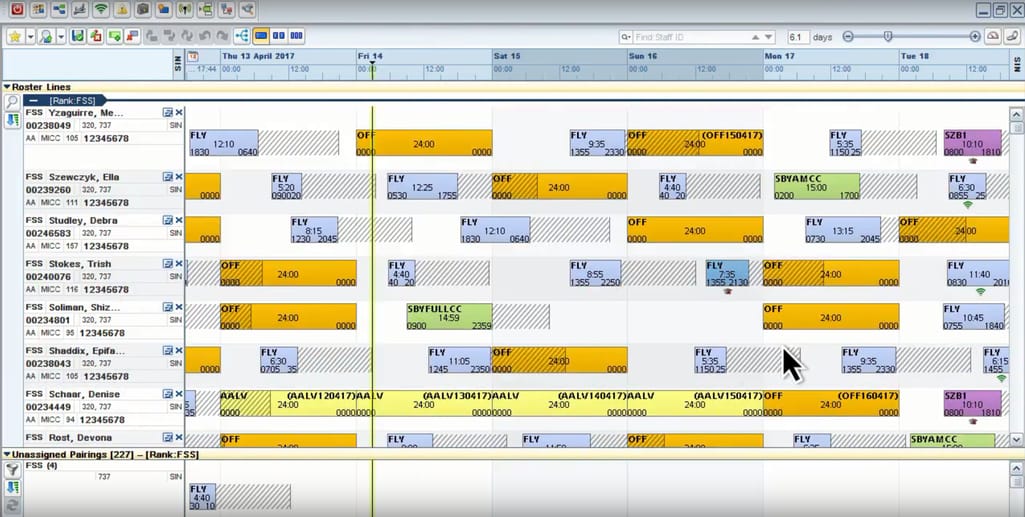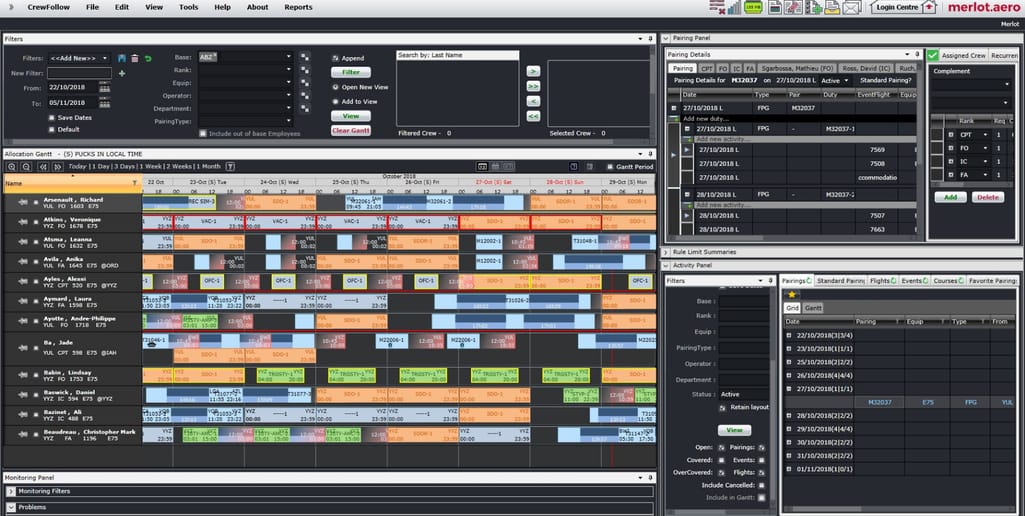On equal footing with fuel, crew related costs are a major operating expense for airlines. Even minor mistakes in dealing with labor resources can result in significant financial losses. The good news is that carriers can save billions of dollars through more sophisticated scheduling systems.
In this article, we’ll talk about the main challenges of crew management, how IT systems cope with them, and what the AltexSoft team has learned from experience with aviation projects. Fasten yout seatbelts and put your seats in the upright position!
Crew planning challenges: pairing, rostering, and bidding
Crew planning or scheduling is one of the most challenging and compute-intensive tasks in the aviation industry, and its complexity increases as crew sizes and the number of flights grow. The whole process is typically divided into two sequential phases: pairing and rostering.
Crew pairing, also known as trips or crew rotations, is a sequence of nonstop flights (flight legs), that starts and ends at the same airport. In other words, it’s an itinerary for a crew that typically spans from one to five days. Planners generate a set of pairings to schedule a timetable for a month. The main goal of this phase is to cover the monthly plan with smallest crew resources possible.
During rostering or assignment phase, pairings and other possible activities like training are assigned to actual crewmembers, according to their qualifications, vacation days, and multiple other parameters.
The important part of rostering is a bidding process that allows pilots and flight attendants to take some control over their allocations. In North America, crewmembers typically bid for predefined anonymous rosters called bidlines. European airlines usually let personnel request destinations, days off, reserve periods, trip lengths, and other elements to create individual rosters. In any case, senior crew members have priority over their colleagues if a conflict arises.
Components of the crew scheduling problem. Source: Team-Oriented Airline Crew Rostering
Overall, crew planning must meet tons of complex rules and requirements dictated by aviation legislation, contractual conditions, and personal expectations. To make things even more complicated, each crew member has between 5 to 100 certificates and licenses with different expiration dates that must be kept current.
Additionally, a perfect final roster considers other details like hotel costs and addresses unexpected changes such as delayed flights or crew illness. And finally, after all the inputs are made, the airline must stay profitable.
Looks almost impossible? However, the steady growth of air transportation indicates that crew planning puzzles are successfully solved day by day, year by year. But not without help from IT solutions.
Crew scheduling software evolution
Until quite recently, crew management in most airlines was accomplished manually, with only pen and paper. Because of the complexity of the problem, it usually took a team of six to eight planners several weeks to accomplish the pairing process for a large airline.
The first wave of optimization: a FORTRAN pioneer from IBM
The first large-scale attempt to solve the crew scheduling problem by means of machines was completed in the early 1970s by IBM’s Airline Marketing Group. A FORTRAN program called TPACS could handle tasks with several thousand constraints and over two million binary variables representing crew assignments. Nine major US airlines bought the technology to optimize initial solutions generated by human planners.
TPACS capabilities were however restricted by the lack of computer power and immaturity of mathematical models applied. Since then, huge research efforts have been focused on crew scheduling. But it was not until the 1990s that significant improvements became possible thanks to advances in technologies and keen interest from airlines.
The second wave of optimization: $20 million savings done
The last decade of the 20th century saw a dramatic increase in air traffic. To stay competitive, airlines started scheduling more flights, which had to fit into extremely congested airspace. Manual planning and scheduling couldn’t facilitate growth anymore. That’s when complex mathematical models and computers were massively introduced to generate rosters.
In 1991, the Trip Reevaluation and Improvement Program (TRIP) reportedly saved American Airlines $20 million within a year by optimizing the crew pairing process. These achievements prompted ten other large US carriers and one railroad company to incorporate the solution.
The European alternative to TRIP, Carmen Systems with headquarters in Gothenburg (Sweden), utilized algorithms developed in the late 1980s at Volvo Data for automotive design. The models had never become popular among car manufacturers. Instead, they powered computationally intensive crew-scheduling applications, with Lufthansa, SAS, Air France, British Airways, and KLM among the first adopters. Back then, the system could optimize rosters within 14 hours of CPU time, and the largest problem it had solved was assigning roughly 22,000 tasks to 7,000 crew members.
The third wave of optimization: addressing flight time limitations and flight fatigue issues
The need for limits on flight and duty time was recognized as far back as 1944. Since then, crew-scheduling practices had to meet strict flight time limitations (FTL). However, due to lack of knowledge about fatigue, old regulations didn’t take into account non-quantitative factors affecting a pilot’s physical condition — such as jet lag or night shifts disrupting sleep-wake rhythms.
During the last decade, new fatigue management policies were developed and supported by major international aviation organizations such as ICAO, IATA, and IFALPA. The European Union Aviation Safety Agency (EASA) also paid a lot of attention to the issue. Its recent report identified long shifts (over 10 hours) and disruptive schedules as the largest fatigue sources while revealing shortcomings of the current FTL rules.
All these posed new challenges to airlines and aviation software companies. Since the early 2010s, the leading providers started including fatigue management tools in their crew management suites. Carriers dependent on systems without such modules can solve this problem by integrating with third-party bio-mathematical models via APIs. For example, the System for Aircrew Fatigue Evaluation (SAFE) model analyzes data from rostering solutions and returns fatigue scores.
Data exchange between rostering and SAFE servers via API. Source: FRMSc
The fourth wave of optimization: migrating to new platforms and technologies
In comparison with airline reservation systems, crew management solutions are relatively new, as they emerged some 25 to 30 years ago. Yet, over the last three decades technologies have been changing so fast that even 10-year-old software seems antiquated, having issues with performance and usability.
To meet modern requirements, many existing rostering solutions need modernization. Some industry leaders have set a good example by moving their facilities to cloud computing platforms like Microsoft Azure. This cost-intensive yet matter-of-course step paves the way for scalability, smooth integration with other advanced technologies, and competitiveness in the market.
Other providers prefer to make fragmentary improvements to their code while sticking to deprecated frameworks, incompatible with most of the modern platforms and tools. However, sooner or later they will “either migrate or die,” as AltexSoft engineers put it.
That’s said, let’s bone up on major players in the crew management systems market that are likely to survive.
Review of crew management suites
Jeppesen Crew Management system
This suite for crew scheduling is a modernized Carmen system, bought in 2006 by Jeppesen, the American pioneer in aeronautical charting and a subsidiary of Boeing. Up to 75 percent of European aircrews use it to get their schedules done. The suite consists of five major components and optional add-ons that can be integrated with the main software on request.
Jeppesen crew planning solutions with main components and some add-ons. Source: Jeppesen
The crew pairing component comes with a promise to cut crew expenses by 3 to 15 percent. including direct costs like hotel stays and deadheads. It enables airlines to manage multiple crew bases, a large number of flights, and many aircraft types at once. The software performs side-by-side comparison and what-if scenario analysis to support data-driven decisions.
The crew pairing process can be boosted by Calibration, an add-on built on top of Boeing AnalytX. It identifies profitable patterns and automatically recommends cost-saving adjustments to the current plan.
The rostering optimizer assigns flights and activities to individual crew members, considering their preferences and adjusting rosters according to that data. Crew members can enter their requests through additional web and mobile apps called Jeppesen Crew Bid. The system supports two bid award models:
- A weighted model, typical for Europe and Latin America. It enables crew members to enter as many bids as they want. But they have to set priorities among preferences to make the system understand what factors are more important for each employee.
- A seniority model, dominating in North America. It awards bids on a seniority basis.
The crew tracking module is designed to spot and resolve changes in the initial crew plans. The system alerts managers about issues like missed documents or crew sickness so that they can quickly analyze and adjust trips and rosters, using what-if scenarios to evaluate the impact of changes.
Also, Jeppesen offers a set of fatigue risk management (FRM) tools designed in cooperation with Boeing and based on scientifically validated fatigue models. The key product is the Boeing Alertness Model that doesn’t have its own interface but works as a plug-in for Jeppesen Crew Pairing, Rostering, and Tracking modules to tailor schedules given the fatigue level. The solution can also be integrated with third-party crew management applications via a cloud API.
Finally, the manpower planning module analyzes career movements, ground duties, and other crew-related factors to optimize resources and develop more accurate budgets. It helps airlines make data-driven decisions about new hires, training, setting leave limits, and so on. Similar to other components of the system, Manpower Planning uses what-if scenarios to model different situations and craft better long-term plans.
Sabre AirCentre Crew Manager platform
Sabre Corporation, the world’s travel industry leader and one of the three largest Global Distribution Systems, started working on crew scheduling solutions in the 1990s. In collaboration with IBM, they created a solution called the Crew Pairing Optimization System (CPOS), incorporated by US Airways. In 1996, the airline reported $50 million in savings annually thanks to CPOS.
In the first decade of the 21st century, Sabre developed a large crew management system, initially used by Singapore Airlines. The pioneering technology managed to solve complex crew-pairing issues of long-haul flights.
Today, Sabre AirCentre Crew Manager platform caters to over 100 airlines worldwide. It uses a highly scalable service-based system and easily integrates with other Sabre or third-party software solutions via a set of APIs. The system contains the following components.
The unified crew pairing and rostering workspace allows airline schedulers to create pairing and assign them to rosters on the same screen. They also can create templates for repeatable schedules, group them by the base, rank, fleet, employment status, and other criteria.
The unified crew pairing and rostering workspace in AirCenter Crew Manager. Source: Sabre
Crew admin embraces a wide range of administration tasks, including:
- training,
- fatigue risk management,
- monitoring legality and rules compliance,
- collecting and analyzing crew preferences, and
- creating customized dashboards.
An additional Recovery Manager Crew system is designed to help planners rebuild and reoptimize damaged crew schedules. Using the latest algorithms, the technology evaluates numerous possible combinations and determines the best solution if a crew member gets sick, loses documents, or some other emergency happens.
Airline analysts can utilize the tool to calculate relative costs of three types of crew repositioning — by their own airline, by other airlines, or by ground transportation.
The Crew Mobile application allows crew members to receive notifications about schedule changes, review their rosters, plan days off, bid for vacations, track their documents and chat with other crew members.
AIMS Crew Management
Founded in 1973 in Dubai (OAE) and engaged in building airline software since 1983, AIMS Corp. is one of the largest providers of crew planning solutions. Its core systems cover a limited set of the most essential tasks relating to:
- crew planning (pairing constructions, manual crew assignment with automated legality checks, basic leave and training administration);
- crew tracking (continuous monitoring of irregularities, crew hotel and travel management, tracking licenses, medical and training records, notifying on schedule changes, etc.); and
- automatic crew assignment supporting three different bidding models.
Airlines can extend the basic functionality according to their specific requirements by integrating different add-ons. AIMS offers over 30 solutions to enhance the core platform including:
- Pairing Generator to automatically create legal and cost-effective pairings from a flight schedule;
- Crew Schedule Costing System to calculate and compare crew expenses considering hotel stays, dead-heading, wages, and other costs;
- Leave Management System to control and improve leave planning for a three-year time frame;
- Cosmic Radiation Tracking module to evaluate the amount of crew exposure to cosmic radiation when flying above the altitude of 25,000 feet;
- Message Distribution System to generate SMS messages in case of flight schedule changes and send them to airline staff;
- Fatigue Risk Management System to incorporate fatigue-related information into the scheduling process; and
- eCrew to provide crew members with access to their personal and company flight information via smartphones, tablets, PCs, or Interactive Voice Response (IVR).
Merlot Aero
In 2019, Merlot Aero (Auckland, New Zealand) received the International Air Transport Award as the "Most Innovative Airline Software Company" for its cloud-based crew management solutions. AltexSoft team were hardly indifferent to that news as our engineers were a part of Merlot Aero’s management solution distributed team for almost ten years, working on the code review, expanding functionality, and UI/UX design for new features.
Currently, the core product from Merlot Aero is comprised of the following planning modules.
The Aircraft Schedule component streamlines the development of flight schedules and pairings considering the needs of customers and legal requirements.
The Crew Plan and Training Plan module sees to all qualification and medical checks, license renewals, annual leave, and administrative needs.
Crew Build and Crew Roster features allow planners to develop efficient solutions, giving the best possible balance between the business goals of the airline and the quality of life for the crew.
Crew planning system dashboard. Source: Microsoft AppSource
Manpower planning and preferential bidding functionality come as additional modules that easily integrate with the core system.
Another optional component — Crew Follow — manages schedule disruptions resulting from sickness, no-shows, or other crew-related issues. For crew members, Merlot Aero offers a CrewMobile application to view schedules, check document expiration dates, and receive notifications from the airline on their smartphones.
In support of their status as innovators, Merlot Aero integrates its solutions with modern platforms providing travel services — such as Uber, Skyscanner, and Airbnb.
Stairway to the cloud
According to recent research, optimization and automation of crew planning processes allow airlines to prevent up to 80 percent of crew-related delays and save billions of dollars annually. Huge benefits stimulate interest in available software solutions and drive the global market of crew management systems, which is expected to grow by almost 10 percent in the next five years.
But crew planning software providers can’t just rest on their laurels waiting for airlines to keep knocking on their doors. To stay competitive, they have to move ahead, changing their interfaces, integrating with other advanced solutions, and adopting new technologies. Currently, "airlines’ IT systems look a bit Jurassic," admitted Tim Clark, president of Emirates Airline. This statement refers to crew management platforms as well, with most of them being created at least two decades ago (by the way, Emirates utilizes the Jeppesen crew planning suite).
In years to come, legacy systems will inevitably face the challenge of cloud migration. How will this process look and where will it start? Here are the main stages of the expected journey:
1. Auditing software landscape and processes to spot pain points and identify feature overlaps.
2. Splitting a monolithic code into smaller services (SOA or microservices architecture) - something that Sabre and Jeppesen did before migrating their facilities to the cloud.
3. Migrating the system incrementally, service by service, with gradual turning off of legacy features.
4. Connecting services with APIs to make them work in sync.
5. Reaping the benefits!
Of course, the whole migration process can take months or even years — depending on system size and complexity. That said, it will be much faster, simpler, and cheaper than developing the first algorithms and building the first computers powerful enough to solve complex crew pairing puzzles.

